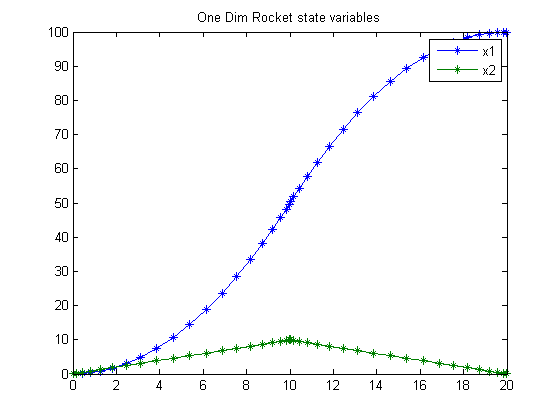One Dimensional Rocket Ascent
User's Guide for DIRCOL
Problem 2.3 One-dimensional ascent of a rocket
Contents
Problem Formulation
Find tCut over t in [0; tF ] to minimize

subject to:



![$$ [x_1 \ x_2] = 0 $$](xonedimRocket_eq04639.png)



% Copyright (c) 2007-2008 by Tomlab Optimization Inc.
Problem setup
toms t toms tCut tp2 p1 = tomPhase('p1', t, 0, tCut, 20); p2 = tomPhase('p2', t, tCut, tp2, 20); tf = tCut+tp2; x1p1 = tomState(p1,'x1p1'); x2p1 = tomState(p1,'x2p1'); x1p2 = tomState(p2,'x1p2'); x2p2 = tomState(p2,'x2p2'); % Initial guess x0 = {tCut==10 tf==15 icollocate(p1,{x1p1 == 50*tCut/10;x2p1 == 0;}) icollocate(p2,{x1p2 == 50+50*t/100;x2p2 == 0;})}; % Box constraints cbox = { 1 <= tCut <= tf-0.00001 tf <= 100 0 <= icollocate(p1,x1p1) 0 <= icollocate(p1,x2p1) 0 <= icollocate(p2,x1p2) 0 <= icollocate(p2,x2p2)}; % Boundary constraints cbnd = {initial(p1,{x1p1 == 0;x2p1 == 0;}) final(p2,x1p2 == 100)}; % ODEs and path constraints a = 2; g = 1; ceq = {collocate(p1,{ dot(p1,x1p1) == x2p1 dot(p1,x2p1) == a-g}) collocate(p2,{ dot(p2,x1p2) == x2p2 dot(p2,x2p2) == -g})}; % Objective objective = tCut; % Link phase link = {final(p1,x1p1) == initial(p2,x1p2) final(p1,x2p1) == initial(p2,x2p2)};
Solve the problem
options = struct;
options.name = 'One Dim Rocket';
constr = {cbox, cbnd, ceq, link};
solution = ezsolve(objective, constr, x0, options);
Problem type appears to be: lpcon
===== * * * =================================================================== * * *
TOMLAB - Tomlab Optimization Inc. Development license 999001. Valid to 2010-02-05
=====================================================================================
Problem: --- 1: One Dim Rocket f_k 9.999998166162908900
sum(|constr|) 0.000733735140223408
f(x_k) + sum(|constr|) 10.000731901303132000
f(x_0) 10.000000000000000000
Solver: snopt. EXIT=0. INFORM=1.
SNOPT 7.2-5 NLP code
Optimality conditions satisfied
FuncEv 1 ConstrEv 10 ConJacEv 10 Iter 8 MinorIter 87
CPU time: 0.031250 sec. Elapsed time: 0.032000 sec.
Plot result
t = [subs(collocate(p1,t),solution);subs(collocate(p2,t),solution)]; x1 = subs(collocate(p1,x1p1),solution); x1 = [x1;subs(collocate(p2,x1p2),solution)]; x2 = subs(collocate(p1,x2p1),solution); x2 = [x2;subs(collocate(p2,x2p2),solution)]; figure(1) plot(t,x1,'*-',t,x2,'*-'); legend('x1','x2'); title('One Dim Rocket state variables');
